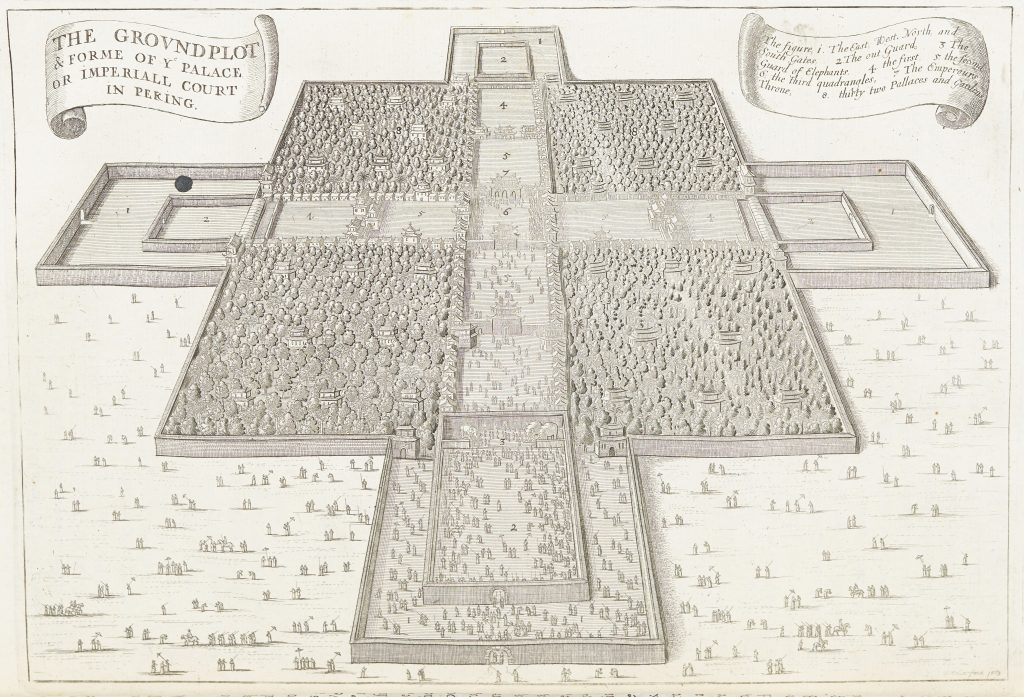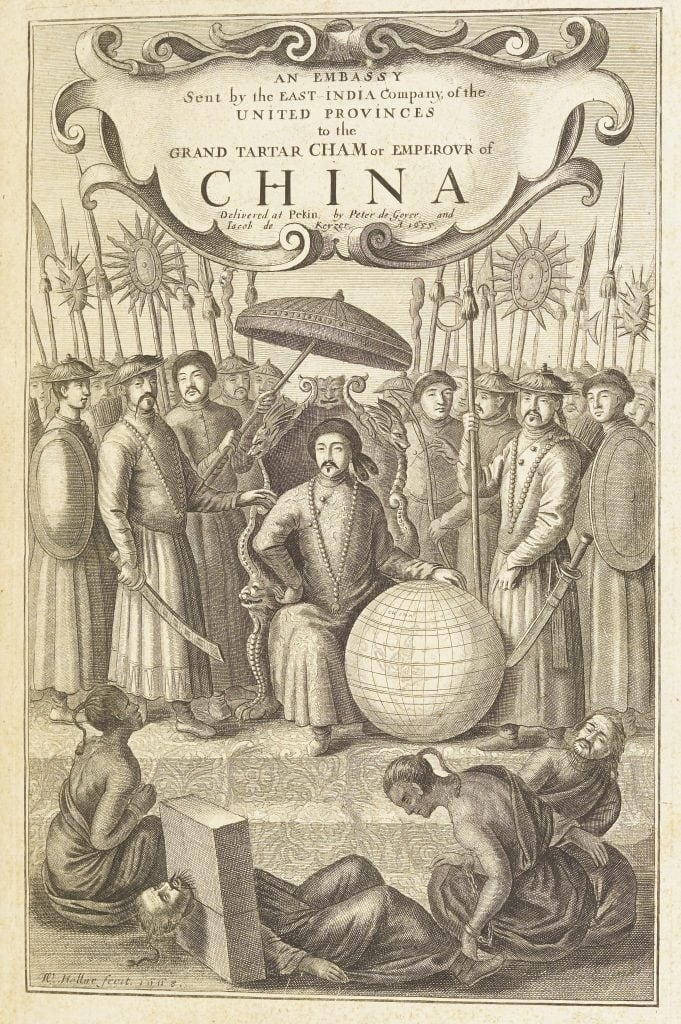
Unlocking the mysteries of a Magdalen College treasure
As a volunteer at the Magdalen College Library, I have been privileged to work with a truly exceptional treasure from our collection: An Embassy from the East-India Company to the Emperor of China, written by the Dutch steward Johan Nieuhof and published in 1665. This formidable volume recounts the long and arduous journey of the Dutch East India Company (VOC) embassy from Batavia to Beijing between 1655 and 1657.
Reading Nieuhof’s account is like embarking on a 17th-century voyage. It is more than just a travelogue; it is an early Western report filled with the limitations and profound curiosity of its time. In this account, two details particularly stand out, capturing the intrigue and challenges of early Sino-Western exchange: Europe’s geographical confusion over “two Chinas” and a delightful, yet telling, list of diplomatic “gifts”.
Context: The VOC, Forbidden Shores, and the 1655 Embassy
The Netherlands, buoyed by the lucrative Far Eastern trade, became a powerful maritime empire in the 17th century. The Dutch East India Company (VOC), chartered in 1602 with broad governmental powers (including diplomacy and warfare), actively sought to expand its Asian markets. However, their mission was challenged by China’s maritime prohibitions, implemented during the late Ming and early Qing dynasties to curb piracy and prevent the resurgence of anti-Qing forces.
The 1655 diplomatic mission, led by envoys Peter de Goyer and Jacob de Keyzer, was the VOC’s first official attempt to secure free trade access following the Qing conquest. They sailed from Batavia (now Jakarta) to Canton, determined to meet the Shunzhi Emperor. Nieuhof, an employee of the VOC, served as the embassy’s steward, responsible for ceremonial matters and accommodation, and—crucially—was tasked with sketching the embassy’s observations along the route.

Despite adhering to the required Chinese protocol, the mission ultimately failed to persuade the Qing court to open its ports for free trade. Nieuhof’s notes and sketches were later entrusted to his brother Hendrik, who published the work in 1665. The book immediately became a European sensation, contributing significantly to the introduction and spread of “Chinoiserie” throughout 18th-century European art and culture.
Part I: A Cartographic Conundrum — From “Cathay” to “China”
In the mid-17th century, European understanding of the Far East was still patchwork. If you look at European maps from that era, you might notice a curious phenomenon: two names for China existed side-by-side—“Cathay” for the north and “China” for the south.
This “tale of two countries” arose from different routes of knowledge transfer:
- The Land Route Legends: Centuries earlier, travellers like Marco Polo returned via the Silk Road, bringing back legendary tales of “Cathay”, a rich kingdom in the north. This name became deeply embedded in the European consciousness.
- The Maritime Trade: With the Age of Exploration, Dutch, Portuguese, and other fleets sailed the oceans, arriving at the southern ports and hearing the name “China” from local traders.
The central question for European geographers became: were Cathay and China one and the same, or two separate empires? This cartographic puzzle persisted for over a hundred years. Nieuhof’s An Embassy was instrumental in delivering the definitive answer. Nieuhof explicitly credits the Jesuit Martinius Martini (known in China as 卫匡国), whose historical and geographical studies had conclusively argued that Cathay and China were indeed one and the same.

The significance of the Dutch Embassy was that its mission — travelling the entire length of the empire from the coastal city of Canton (Guangzhou)to the northern Imperial City of Peking (Beijing) — provided the crucial physical confirmation of Martini’s academic theory. Nieuhof’s firsthand account thus solidified the new, unified understanding of the massive and singular Chinese Empire in the European imagination.

Part II: What to Get an Emperor? A 17th-Century Gift Guide
Having solved the map mystery, we turn to the embassy’s most delicate task: winning favour with the Qing Emperor. What did the powerful Dutch East India Company choose as the ultimate diplomatic “parting gifts”?
The comprehensive gift list is a fascinating document in its own right, a humorous look at 17th-century diplomatic efforts:
| Recipient | Gift Highlights (Partial List) | Cultural and Commercial Insight |
| His Imperial Majesty | Suit of Gold-Embossed Armour, Twenty-Three Swords, Muskets, Five Chests of Nutmegs, Chest of Cloves. | The armour and muskets served as a show of European technology; the spices (nutmeg and cloves) were the core of the VOC’s immense wealth and power—commodities then more valuable than gold—a token of their commercial empire. |
| The Empress | A Large Looking-Glass, Crystal Cabinet, Italian Marble Tables (Inlay’d with pictures), Eight Ells of Holland Cloth. | The looking-glass and crystal represent the cutting-edge of European manufacturing technology; the marble and cloth showcased European luxury and domestic aesthetics. |
| The Empress Mother | Tortoiseshell Cabinet Inlay’d with Silver, Ebony Cabinet Inlay’d with Silver, Amber and Coral Beads. | The focus on amber and coral, valued for their beauty and perceived medicinal qualities in both cultures, was a strategic attempt to appeal to the Imperial taste for precious, intricate objects. |

The irony is that despite the opulence of these gifts—which perfectly demonstrated European technological prowess and commercial dominance—Nieuhof records that the mission ultimately failed to secure the desired free trade agreement. The Emperor’s final decree allowed the embassy to return only once every eight years, a diplomatic slight that amounted to a subtle prohibition.
The Historical Lens: How to Read a 17th-Century Report
It is important to note that Nieuhof’s An Embassy to the Emperor of China is not an unvarnished diary. Historians agree that the work was heavily embellished and edited by its publishers (including Nieuhof’s brother, Hendrik) to maximise commercial success and satisfy 17th-century Europe’s fascination with the exotic.
We must, therefore, approach this record through a “historical filter”. As a VOC document, the report aimed to advance trade interests. Consequently, while it showcases the richness of China, it inevitably carries the inherent biases and colonial self-regard of 17th-century Europe.

The book’s fame largely rests on its detailed, striking etchings. However, experts confirm that many images were re-created or even imagined by European engravers based on Nieuhof’s initial sketches. This re-creation process meant the illustrations often incorporated European artistic styles and exaggerated the “exotic” nature of China. Nieuhof’s travel account is considered one of the biggest influences on Western “Chinoiserie”.
The enduring value of this book lies precisely in its nature as an invaluable sample of cultural contact, documenting the complex blend of wonder, misunderstanding, and the earnest effort to communicate between two vastly different civilisations.
A Legacy Preserved at Magdalen
Johan Nieuhof’s An Embassy from the East-India Company remains an essential historical record. It allows us to step back four centuries and witness, through a European lens, the beginnings of a complex relationship defined by grand architecture, sophisticated statecraft, commercial ambition, and profound cultural misunderstanding.
As a precious item in the Magdalen College Library, this volume’s value is immense. It serves as a tangible prompt for reflection, encouraging us to look beyond the surface—past the biases and the exaggerations—to appreciate the sheer audacity and human curiosity that drove these early attempts at global communication.
Written by Yanjing Lu (MSc Sociology, Kellogg College), who volunteered in the Old Library and Longwall Library during the summer of 2025
Further Reading
Many helpful references can be accessed via the Wikipedia page for this book.
Pān, Y. (2023). ‘Hé shǐ chū fǎng zhōng guó jì” tú wén tànxī’ [‘A Pictorial Analysis of “The First Visit of the Dutch Envoy to China”’], in Wénhuà zázhì [Culture Magazine], 118, 194-203. Available at: https://www.icm.gov.mo/rc/viewer/pdfViewerParts/10118/4219